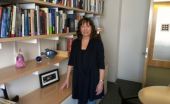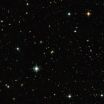(Press-News.org) SAN FRANCISCO—In the search for rogue nukes, researchers have discovered an unlikely tool: astronomical radio telescopes.
Ohio State University researchers previously demonstrated another unlikely tool, when they showed that South Korean GPS stations detected telltale atmospheric disturbances from North Korea's 2009 nuclear test.
Both techniques were born out of the discovery that underground nuclear explosions leave their mark—on the outer reaches of Earth's atmosphere.
Now, working with astronomers at the U.S. Naval Research Laboratory (NRL), they have analyzed historical data from the Very Large Array (VLA), a constellation of 27 radio telescopes near Socorro, New Mexico—and discovered that the VLA recorded a very similar pattern of disturbances during the last two American underground nuclear tests, which took place in Nevada in 1992.
Dorota Grejner-Brzezinska, professor of geodetic and geoinformation engineering at Ohio State, said that the new findings help support the notion that GPS systems—and their technological successors, global navigation satellite systems (GNSS)—are viable tools for detecting clandestine nuclear tests around the globe. She added that now is a good time to begin developing the concept.
"With a global availability of permanently tracking GPS networks now extending to GNSS, tremendous amounts of information are becoming available, and the infrastructure is growing," she said. "We have a great opportunity to develop these ideas, and make a tool that will aid the global community."
Grejner-Brzezinska presented the findings in a press conference at the American Geophysical Union (AGU) meeting on Dec. 4 with study co-authors Jihye Park, a postdoctoral researcher in geodetic and geoinformation engineering at Ohio State, and Joseph Helmboldt, a radio astronomer at NRL. Park presented the research in a lecture at AGU on Dec. 3.
While radio telescopes don't cover the entire globe as GPS systems do, Helmboldt said that the two technologies complement each other, with telescopes offering higher-resolution measurements over a smaller area.
"The observations we make as radio astronomers are not so different from GPS," he said. "We may be looking up at a distant galaxy instead of down to the Earth, but either way, we're all looking at radio waves traveling through the ionosphere."
The ionosphere is the outermost layer of the atmosphere, which begins approximately 50 miles above the Earth's surface. It contains charged particles that can interfere with radio waves and cause measurement errors in GPS and radio telescopes.
For that reason, both radio astronomers and geodetic scientists routinely monitor the ionosphere in order to detect these errors and compensate for them.
"We're talking about taking the error patterns—basically, the stuff we usually try to get rid of—and making something useful out of it," Grejner-Brzezinska said.
Park, who developed this analysis method to earn her doctoral degree at Ohio State, cited key similarities and differences between the GPS data from the 2009 North Korean nuclear test and the VLA data from the 1992 American tests: one on Sept. 18 named Hunters Trophy, and the other on Sept. 23, named Divider.
The North Korean bomb is believed to have had a yield of about five kilotons. According to the GPS data, the wave front of atmospheric disturbance spread outward from the test site in the village of P'unggye at approximately 540 miles per hour. It reached 11 GPS stations in South Korea, China, Japan, and Russia in that first hour. In contrast, Hunters Trophy and Divider each had yields of 20 kilotons. Each blast created a wave front that quickly covered the 700 miles from the Nevada Test Site to the VLA, with a top speed of approximately 1,500 miles per hour.
"Clearly, the U.S. explosions were much bigger than the North Korean explosion," Park said. "The wave fronts traveled faster, and the amplitudes were higher. There are still details missing from the North Korean test, but we can learn a lot by comparing the two events."
Park will continue this work while she takes a new position at the University of Nottingham starting in January. She's already found that GPS stations in the North Pacific recorded ionospheric disturbances during the deadly Japanese earthquake of 2011, and she will focus on how to differentiate between earthquake signals and nuclear test signals.
### Collaborators on this work include Ralph R. von Frese, professor in the School of Earth Sciences at Ohio State; Yu "Jade" Morton, professor in electrical engineering at Miami University in Oxford, Ohio; and Thomas Wilson, an astronomer at NRL.
Contacts: Dorota Grejner-Brzezinska, DBrzezinska@osu.edu
Jihye Park, Park.898@osu.edu
Joseph Helmboldt, (202) 404-6340; Joe.Helmboldt@nrl.navy.mil
Written by Pam Frost Gorder, (614) 292-9475; Gorder.1@osu.edu
Editor's note: Both Grejner-Brzezinska and Park are best reached by email; contact Pam Frost Gorder to reach any of the sources during the meeting, or to request an image of a wave front recorded by the VLA.
Seeing stars, finding nukes: Radio telescopes can spot clandestine nuclear tests
2012-12-05
ELSE PRESS RELEASES FROM THIS DATE:
Atherosclerosis found in HIV children
2012-12-05
Athens, Greece – 5 December 2012: Children with HIV have a 2.5 fold increased risk of atherosclerosis, according to research1 presented at EUROECHO and other Imaging Modalities 2012. Antiretroviral treatment, lipid lowering drugs and prevention with healthy lifestyles are needed to prevent early death from cardiovascular disease.
EUROECHO and other Imaging Modalities 2012 is the annual meeting of the European Association of Cardiovascular Imaging (EACVI)2, a registered branch of the European Society of Cardiology (ESC)3. It takes place 5-8 December in Athens, Greece, ...
Treat snoring to avoid deadly heart failure
2012-12-05
Athens, Greece – 5 December 2012: Patients with obstructive sleep apnea have the same early cardiovascular damage as diabetics, according to research presented at EUROECHO and other Imaging Modalities 2012. The study1 was presented by Dr Raluca Mincu from Bucharest, Romania.
EUROECHO and other Imaging Modalities 2012 is the annual meeting of the European Association of Cardiovascular Imaging (EACVI)2, a registered branch of the European Society of Cardiology (ESC)3. It takes place 5-8 December in Athens, Greece, at the Megaron Athens International Conference Centre.
Obstructive ...
Rejected hearts now viable for transplantation after stress echo
2012-12-05
Athens, Greece – 5 December 2012: Hearts previously rejected due to donors' age or other risk factors can now be declared viable for transplantation using pharmacological stress echo, according to research presented at EUROECHO and other Imaging Modalities 2012. The study1 was presented by Dr Tonino Bombardini from Pisa, Italy.
EUROECHO and other Imaging Modalities 2012 is the annual meeting of the European Association of Cardiovascular Imaging (EACVI)2, a registered branch of the European Society of Cardiology (ESC)3. It takes place 5-8 December in Athens, Greece, at ...
Where 'where it's at' is at in the brain
2012-12-05
Conventional wisdom in brain research says that you just used your hippocampus to answer that question, but that might not be the whole story. The context of place depends on not just how you got there, but also the things you see around you. A new study in Neuron provides evidence that a different part of the brain is important for understanding where you are based on the spatial layout of the objects in that place. The finding, in rats, has a direct analogy to primate neuroanatomy.
"Understanding how and where context is represented in the brain is important," said ...
Study shows antibody therapy clears Alzheimer's plaques in mice
2012-12-05
Antibodies against amyloid beta (Aβ) protein deposits that are thought to play a role in Alzheimer's disease have shown some success in preventing the buildup of deposits in animals, but they have not been effective at removing preexisting deposits. Now researchers reporting in the December issue of the Cell Press journal Neuron show that a modified antibody was able to clear preexisting Aβ deposits in a mouse model of Alzheimer's disease.
"These findings have important implications for current and future development of antibodies for the treatment of Alzheimer's ...
Galaxy-wide echoes from the past
2012-12-05
Many galaxies have a giant black hole at their centre that causes the gas around it to glow. However, in the case of green bean galaxies, the entire galaxy is glowing, not just the centre. These new observations reveal the largest and brightest glowing regions ever found, thought to be powered by central black holes that were formerly very active but are now switching off.
Astronomer Mischa Schirmer of the Gemini Observatory had looked at many images of the distant Universe, searching for clusters of galaxies, but when he came across one object in an image from the Canada-France-Hawaii ...
Mayo Clinic: Less invasive surgery detects residual breast cancer in lymph nodes after chemotherapy
2012-12-05
ROCHESTER, Minn. — Most patients whose breast cancer has spread to their lymph nodes have most of the lymph nodes in their armpit area removed after chemotherapy to see if any cancer remains. A study conducted through the American College of Surgeons Oncology Group and led by Judy Boughey, M.D. a breast surgeon at Mayo Clinic shows that a less invasive procedure known as sentinel lymph node surgery successfully identified whether cancer remained in lymph nodes in 91 percent of patients with node-positive breast cancer who received chemotherapy before their surgery. In sentinel ...
Scientists pinpoint great-earthquake hot spots
2012-12-05
"We find that 87% of the 15 largest (8.6 magnitude or higher) and half of the 50 largest (8.4 magnitude or higher) earthquakes of the past century are associated with intersection regions between oceanic fracture zones and subduction zones," says Dietmar Müller, researcher at the University of Sydney in Australia and lead author of the Solid Earth paper. The connection is less striking for smaller earthquakes.
Powerful earthquakes related to these intersection regions include the destructive 2011 Tohoku-Oki and 2004 Sumatra events.
"If the association we found were ...
URI oceanography student uses crashing waves on shorelines to study Earth's interior
2012-12-05
NARRAGANSETT, R.I. – December 5, 2012 – Scientists have long used the speed of seismic waves traveling through the Earth as a means of learning about the geologic structure beneath the Earth's surface, but the seismic waves they use have typically been generated by earthquakes or man-made explosions. A University of Rhode Island graduate student is using the tiny seismic waves created by ocean waves crashing on shorelines around the world to learn how an underwater plateau was formed 122 million years ago.
"There are any number of ways to create seismic waves, but most ...
Wind speeds in southern New England declining inland, remaining steady on coast
2012-12-05
NARRAGANSETT, R.I. – December 5, 2012 – Oceanographers at the University of Rhode Island have analyzed long-term data from several anemometers in southern New England and found that average wind speeds have declined by about 15 percent at inland sites while speeds have remained steady at an offshore site.
Kelly Knorr, a graduate student at the URI Graduate School of Oceanography, and Professor John Merrill reported the results of their research today at the fall meeting of the American Geophysical Union in San Francisco.
The researchers found that average wind speeds ...

